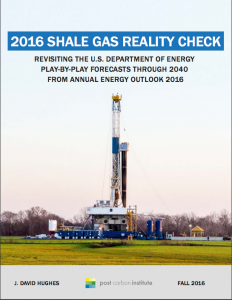Full Title: 2016 Shale Gas Reality Check
Author(s): J. David Hughes
Publisher(s): Post Carbon Institute
Publication Date: December 1, 2016
Full Text: Download Resource
Description (excerpt):
U.S. gas production was thought to be in permanent decline as recently as 2005. The advent of shale gas over the past decade has, however, dramatically turned this around and increased production to all-time highs. Notwithstanding this, U.S. gas production peaked in mid-2015 and shale gas production peaked in early 2016, according to the Energy Information Administration (EIA). The question is: How fast and how much can production grow in the future given higher prices and a return to higher rates of drilling? Given that shale gas is the major source of hope for growing or even maintaining U.S. gas production, a view to the future of shale gas production is critical for establishing energy policy and avoiding unforeseen supply shortfalls.
EIA forecasts of gas production published in its Annual Energy Outlook (AEO) are viewed by industry and government policy makers as the best available assessment of what to expect in the longer term, with the EIA’s reference case typically viewed as the most likely scenario for future production. In the report Drilling Deeper, published in October 2014, I reviewed the credibility of the EIA’s Annual Energy Outlook 2014 (AEO2014) forecasts for the major U.S. tight oil and shale gas plays based on the fundamental geological characteristics of each play; I also developed alternate production forecasts for each of the major shale gas plays. The EIA’s AEO2014 reference case projection over-estimated gas recovery from 2014 to 2040 by 53% compared to the “Most Likely” Drilling Deeper case. AEO20155 and AEO20166 were 50% and 83% higher, respectively, than Drilling Deeper for the same period. The EIA projections are likewise considerably more optimistic than those of the University of Texas Bureau of Economic Geology (UTBEG) for the four plays it has assessed.
The EIA recently released AEO2016 and kindly provided the underlying play-by-play production estimates for shale gas that make up its reference case. This report compares the forecasts in AEO2016 to the “Most Likely” case in Drilling Deeper and to the AEO2014 and AEO2015 forecasts; such comparisons are instructive in evaluating the volatility of EIA estimates for the same plays in forecasts separated by just one year, which reflects on their likely long-term accuracy. This report also assigns an “optimism bias” of the EIA’s forecast for each play (summarized in Table 2, page 32).
